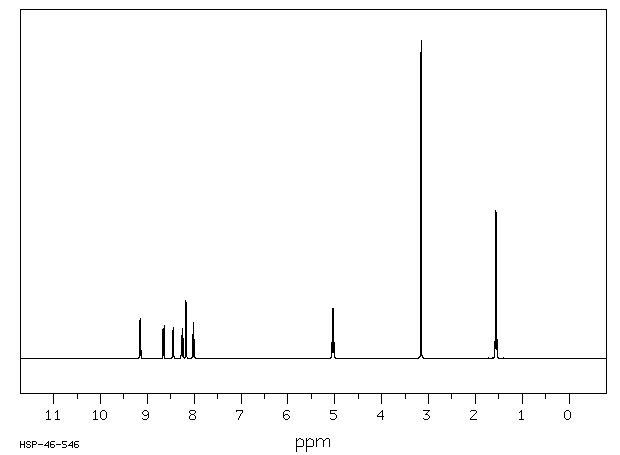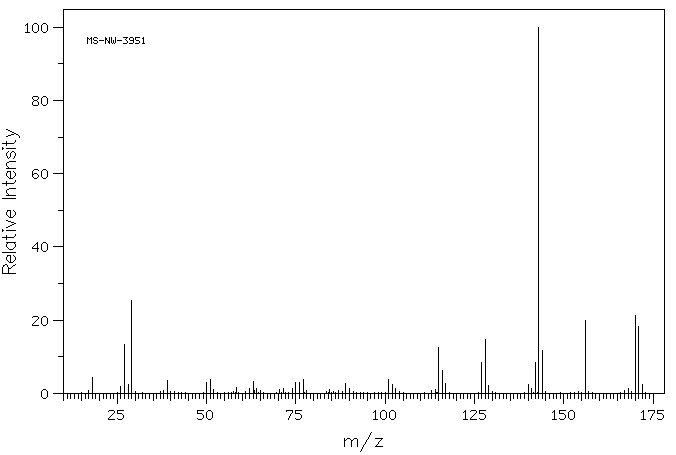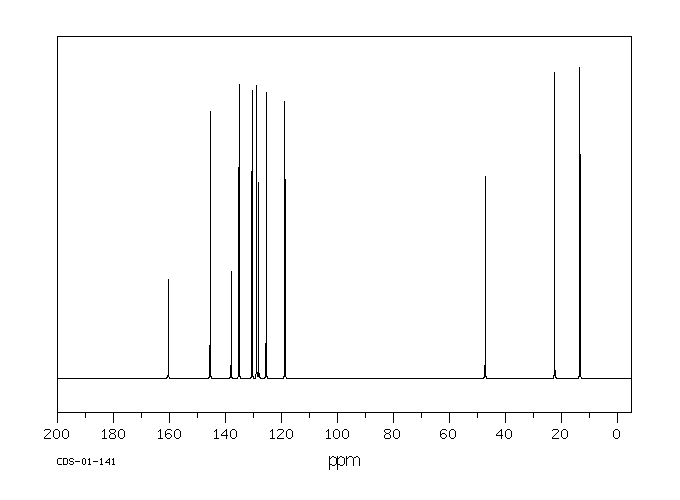N-乙基碘化喹醛啶 | 606-55-3
中文名称
N-乙基碘化喹醛啶
中文别名
喹醛啶碘乙烷;碘化N-乙基喹那啶;1-乙基-2-甲基碘化喹啉;1-乙基甲基碘化喹啉;碘化-N-乙基喹那啶
英文名称
1-ethyl-2-methylquinolinium iodide
英文别名
N-ethyl-2-methylquinolinium iodide;N-ethylquinaldinium iodide;quinaldine ethiodide;1-ethyl-2-methylquinolin-1-ium;iodide
CAS
606-55-3
化学式
C12H14N*I
mdl
——
分子量
299.154
InChiKey
OEVSHJVOKFWBJY-UHFFFAOYSA-M
BEILSTEIN
——
EINECS
——
-
物化性质
-
计算性质
-
ADMET
-
安全信息
-
SDS
-
制备方法与用途
-
上下游信息
-
文献信息
-
表征谱图
-
同类化合物
-
相关功能分类
-
相关结构分类
物化性质
-
熔点:244 °C (dec.)(lit.)
-
密度:1.4877 (estimate)
-
溶解度:250克/升
-
稳定性/保质期:
性质与稳定性:在常温常压下,不会发生分解反应。
计算性质
-
辛醇/水分配系数(LogP):-0.54
-
重原子数:14
-
可旋转键数:1
-
环数:2.0
-
sp3杂化的碳原子比例:0.25
-
拓扑面积:3.9
-
氢给体数:0
-
氢受体数:1
安全信息
-
TSCA:Yes
-
危险品标志:Xi
-
安全说明:S26,S37/39
-
危险类别码:R36/37/38
-
WGK Germany:3
-
海关编码:2933 49 90
-
RTECS号:VA0740000
-
危险性防范说明:P261,P264,P270,P271,P280,P301+P312+P330,P302+P352+P312+P362+P364,P304+P340+P312,P501
-
危险性描述:H302+H312+H332
-
储存条件:贮存: 将密器密封后,储存在密封的主容器中,并放置在阴凉、干燥处。
SDS
| Name: | 1-Ethylquinaldinium Iodide 97% (titr.) Material Safety Data Sheet |
| Synonym: | N-ethylquinaldinium; 1-ethyl-2-methylquinolinium iodide; 2-methylquinoline ethiodide; Quinaldine ethiodide; Quinolinium, 1-ethyl-2methyl, iodide (9CI |
| CAS: | 606-55-3 |
Synonym:N-ethylquinaldinium; 1-ethyl-2-methylquinolinium iodide; 2-methylquinoline ethiodide; Quinaldine ethiodide; Quinolinium, 1-ethyl-2methyl, iodide (9CI
Section 2 - COMPOSITION, INFORMATION ON INGREDIENTS
| CAS# | Chemical Name | content | EINECS# |
| 606-55-3 | Quinolinium, 1-ethyl-2-methyl-, iodide | 97% | 210-120-7 |
Risk Phrases: 36/37/38
Section 3 - HAZARDS IDENTIFICATION
EMERGENCY OVERVIEW
Irritating to eyes, respiratory system and skin.Moisture sensitive.The toxicological properties of this material have not been fully investigated.
Potential Health Effects
Eye:
Causes eye irritation.
Skin:
Causes skin irritation.
Ingestion:
May cause irritation of the digestive tract.
Inhalation:
Causes respiratory tract irritation.
Chronic:
No information found.
Section 4 - FIRST AID MEASURES
Eyes: Immediately flush eyes with plenty of water for at least 15 minutes, occasionally lifting the upper and lower eyelids. Get medical aid immediately.
Skin:
Get medical aid. Immediately flush skin with plenty of water for at least 15 minutes while removing contaminated clothing and shoes.
Ingestion:
Do not induce vomiting. If victim is conscious and alert, give 2-4 cupfuls of milk or water. Never give anything by mouth to an unconscious person. Get medical aid immediately.
Inhalation:
Remove from exposure and move to fresh air immediately. If not breathing, give artificial respiration. If breathing is difficult, give oxygen. Get medical aid.
Notes to Physician:
Section 5 - FIRE FIGHTING MEASURES
General Information:
As in any fire, wear a self-contained breathing apparatus in pressure-demand, MSHA/NIOSH (approved or equivalent), and full protective gear. During a fire, irritating and highly toxic gases may be generated by thermal decomposition or combustion.
Extinguishing Media:
Use water spray, dry chemical, carbon dioxide, or appropriate foam.
Section 6 - ACCIDENTAL RELEASE MEASURES
General Information: Use proper personal protective equipment as indicated in Section 8.
Spills/Leaks:
Clean up spills immediately, observing precautions in the Protective Equipment section. Sweep up, then place into a suitable container for disposal. Avoid generating dusty conditions.
Section 7 - HANDLING and STORAGE
Handling:
Wash thoroughly after handling. Use with adequate ventilation. Avoid contact with skin and eyes. Avoid ingestion and inhalation.
Storage:
Store in a cool, dry place. Keep container closed when not in use.
Section 8 - EXPOSURE CONTROLS, PERSONAL PROTECTION
Engineering Controls:
Use adequate ventilation to keep airborne concentrations low.
Exposure Limits CAS# 606-55-3: Personal Protective Equipment Eyes: Wear appropriate protective eyeglasses or chemical safety goggles as described by OSHA's eye and face protection regulations in 29 CFR 1910.133 or European Standard EN166.
Skin:
Wear appropriate protective gloves to prevent skin exposure.
Clothing:
Wear appropriate protective clothing to prevent skin exposure.
Respirators:
Follow the OSHA respirator regulations found in 29 CFR 1910.134 or European Standard EN 149. Use a NIOSH/MSHA or European Standard EN 149 approved respirator if exposure limits are exceeded or if irritation or other symptoms are experienced.
Section 9 - PHYSICAL AND CHEMICAL PROPERTIES
Physical State: Powder
Color: yellow
Odor: Not available.
pH: Not available.
Vapor Pressure: Not available.
Viscosity: Not available.
Boiling Point: Not available.
Freezing/Melting Point: 244 deg C (dec)
Autoignition Temperature: Not available.
Flash Point: Not available.
Explosion Limits, lower: Not available.
Explosion Limits, upper: Not available.
Decomposition Temperature:
Solubility in water:
Specific Gravity/Density:
Molecular Formula: C12H14IN
Molecular Weight: 299.14
Section 10 - STABILITY AND REACTIVITY
Chemical Stability:
Stable under normal temperatures and pressures.
Conditions to Avoid:
Incompatible materials, moisture.
Incompatibilities with Other Materials:
Strong oxidizing agents.
Hazardous Decomposition Products:
Nitrogen oxides, carbon monoxide, irritating and toxic fumes and gases, carbon dioxide, hydrogen iodide, iodide ions (I-).
Hazardous Polymerization: Has not been reported
Section 11 - TOXICOLOGICAL INFORMATION
RTECS#:
CAS# 606-55-3: VA0740000 LD50/LC50:
Not available.
Carcinogenicity:
Quinolinium, 1-ethyl-2-methyl-, iodide - Not listed by ACGIH, IARC, or NTP.
Other:
See actual entry in RTECS for complete information.
Section 12 - ECOLOGICAL INFORMATION
Section 13 - DISPOSAL CONSIDERATIONS
Dispose of in a manner consistent with federal, state, and local regulations.
Section 14 - TRANSPORT INFORMATION
IATA
Not regulated as a hazardous material.
IMO
Not regulated as a hazardous material.
RID/ADR
Not regulated as a hazardous material.
Section 15 - REGULATORY INFORMATION
European/International Regulations
European Labeling in Accordance with EC Directives
Hazard Symbols: XI
Risk Phrases:
R 36/37/38 Irritating to eyes, respiratory system
and skin.
Safety Phrases:
S 24/25 Avoid contact with skin and eyes.
S 26 In case of contact with eyes, rinse immediately
with plenty of water and seek medical advice.
S 36/37/39 Wear suitable protective clothing, gloves
and eye/face protection.
WGK (Water Danger/Protection)
CAS# 606-55-3: No information available.
Canada
CAS# 606-55-3 is listed on Canada's DSL List.
CAS# 606-55-3 is not listed on Canada's Ingredient Disclosure List.
US FEDERAL
TSCA
CAS# 606-55-3 is listed on the TSCA inventory.
SECTION 16 - ADDITIONAL INFORMATION
N/A
反应信息
-
作为反应物:描述:参考文献:名称:Zenno, Yakugaku Zasshi/Journal of the Pharmaceutical Society of Japan, 1953, vol. 73, p. 595摘要:DOI:
-
作为产物:描述:参考文献:名称:格氏试剂和二烷基镉对烷基喹啉鎓盐和烷基异喹啉鎓盐的作用。阴离子的基本强度与其在核取代反应中的取向之间的关系摘要:DOI:10.1039/jr9540002770
文献信息
-
New Synthetic Approach to Aminosquarylium Cyanine Dyes作者:P. F. Santos、L. V. Reis、J. P. Serrano、P. AlmeidaDOI:10.1055/s-2002-34226日期:——A novel synthesis of aminosquarylium cyanine dyes, based on the methylation of readily available squarylium dyes with methyl triflate, followed by nucleophilic substitution with appropriate aliphatic amines, was disclosed. By this procedure several new aminosquarylium cyanine dyes bearing benzothiazole, benzoselenazole and quinoline nuclei were prepared.
-
2-[3H-THIAZOL-2-YLIDINEMETHYL]PYRIDINES AND RELATED COMPOUNDS AND THEIR USE申请人:Brown Robert公开号:US20090247579A1公开(公告)日:2009-10-01The present invention pertains to certain 2-[3H-thiazol-2-ylidinemethyl]pyridine compounds and analogs thereof, which, inter alia, inhibit cell proliferation, treat cancer, etc., and more specifically to compounds of the following formula, wherein R A1 , R A2 , R A3 , R A4 , R B1 , R B2 , R NA , R NB , and X − are as defined herein: The present invention also pertains to pharmaceutical compositions comprising such compounds, and the use of such compounds and compositions, both in vitro and in vivo, to inhibit cell proliferation, and in the treatment of proliferative conditions such as cancer, etc.
-
Dye including an anchoring group in its molecular structure申请人:Fuhrmann Gerda公开号:US08440840B2公开(公告)日:2013-05-14A dye including an anchoring group in its molecular structure, said anchoring group allowing a covalent coupling of said dye to a surface, for example a surface of a nanoporous semiconductor layer, said anchoring group being represented by formula 1 wherein attachment of said anchoring group within said molecular structure of said dye is at the terminal carbon marked with an asterisk in above formula, wherein G is selected from —COOH, —SO3H, —PO3H2, —BO2H2, —SH, —OH, —NH2, preferably —COOH, wherein A is selected from the group comprising H, —CN, —NO2, —COOR, —COSR, —COR, —CSR, —NCS, —CF3, —CONR2-OCF3, C6H5-mFm, wherein m=1-5, R being H or any straight or branched alkyl chain of general formula —CnH2n+I, n=O-12, preferably 0-4, or any substituted or non-substituted phenyl or biphenyl.
-
Synthesis and Spectroscopic Characterisation of N-Alkyl Quaternary Ammonium Salts Typical Precursors of Cyanines作者:A. Pardal、S. Ramos、P. Santos、L. Reis、P. AlmeidaDOI:10.3390/70300320日期:——The synthesis and spectroscopic characterisation of some representative N-alkyl-substituted quaternary ammonium salts derived from benzothiazole, benzoxazole, benzo-selenazole, indole and quinoline are described. These heterocyclic salts, bearing an activated methyl group in the 2-position in relation to the nitrogen atom and N-methyl, -pentyl, -hexyl and -decyl chains, are typical precursors of cyanine
-
An Activatable AIEgen Probe for High‐Fidelity Monitoring of Overexpressed Tumor Enzyme Activity and Its Application to Surgical Tumor Excision作者:Haidong Li、Qichao Yao、Feng Xu、Yueqing Li、Dayeh Kim、Jeewon Chung、Gain Baek、Xiaofeng Wu、Prima Fitria Hillman、Eun Young Lee、Haoying Ge、Jiangli Fan、Jingyun Wang、Sang‐Jip Nam、Xiaojun Peng、Juyoung YoonDOI:10.1002/anie.202001675日期:2020.6.15Monitoring fluctuations in enzyme overexpression facilitates early tumor detection and excision. An AIEgen probe (DQM‐ALP) for the imaging of alkaline phosphatase (ALP) activity was synthesized. The probe consists of a quinoline‐malononitrile (QM) core decorated with hydrophilic phosphate groups as ALP‐recognition units. The rapid liberation of DQM‐OH aggregates in the presence of ALP resulted in aggregation‐induced
表征谱图
-
氢谱1HNMR
-
质谱MS
-
碳谱13CNMR
-
红外IR
-
拉曼Raman
-
峰位数据
-
峰位匹配
-
表征信息
同类化合物
(S)-4-(叔丁基)-2-(喹啉-2-基)-4,5-二氢噁唑
(SP-4-1)-二氯双(喹啉)-钯
(E)-2-氰基-3-[5-(2,5-二氯苯基)呋喃-2-基]-N-喹啉-8-基丙-2-烯酰胺
(8α,9S)-(+)-9-氨基-七氢呋喃-6''-醇,值90%
(6,7-二甲氧基-4-(3,4,5-三甲氧基苯基)喹啉)
(1-羟基-5-硝基-8-氧代-8,8-dihydroquinolinium)
黄尿酸 8-甲基醚
麻保沙星EP杂质D
麻保沙星EP杂质B
麻保沙星EP杂质A
麦角腈甲磺酸盐
麦角腈
麦角灵
麦皮星酮
麦特氧特
高铁试剂
高氯酸3-苯基[1,3]噻唑并[3,2-f]5-氮杂菲-4-正离子
马波沙星EP杂质F
马波沙星
马来酸茚达特罗杂质
马来酸茚达特罗
马来酸维吖啶
马来酸来那替尼
马来酸四甲基铵
香草木宁碱
颜料红R-122
颜料红210
颜料红
顺式-苯并(f)喹啉-7,8-二醇-9,10-环氧化物
顺式-(alphaR)-N-(4-氯苯基)-4-(6-氟-4-喹啉基)-alpha-甲基环己烷乙酰胺
非那沙星
非那沙星
青花椒碱
青色素863
雷西莫特
隐花青
阿莫地喹-d10
阿莫地喹
阿莫吡喹N-氧化物
阿美帕利
阿米诺喹
阿立哌唑溴代杂质
阿立哌唑杂质B
阿立哌唑杂质38
阿立哌唑杂质1750
阿立哌唑杂质13
阿立哌唑杂质
阿立哌唑杂质
阿尔马尔
阿加曲班杂质43










